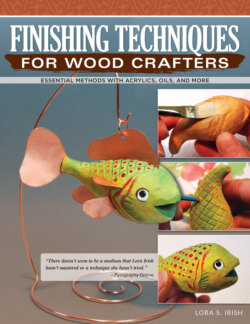Читать книгу Finishing Techniques for Wood Crafters - Lora S. Irish - Страница 10
Primers
ОглавлениеA primer is an acrylic base coat that is applied over the raw wood before the individual colors are painted. Primer blocks out the wood grain so that the paints take on a bright, clean appearance. There are pre-mixed primers available that have little or no shine, which allows the paint to adhere well. However, most pre-mixed primers are pure white and have a gritty finish. If you are using a pre-mixed primer, thin it on a palette with 2 parts primer to 1 part water.
You can also create your own primer using the paints you have on hand, which is what I prefer to do. I usually thin my primer with several drops of water added to a quarter-sized puddle of primer on the palette. The extra water in the mix slows the drying rate of the paint to give you extra time to smooth out each brushful of color. The colors you will be using on your project determine what color of primer you should use, which is another reason to use your own paints as primers. Here is a breakdown of some primer color options and when to use them.
White primers work very well for pale and pastel colors and for white areas.
If an area will be red, orange, purple, bright green, or bright blue, you can use a pale gray primer. Because red and orange are pure hues, they contain no white, black, or gray coloration. This means they are semi-transparent, allowing some light to show through thin coats. A gray primer blocks the light and makes the color appear much more opaque.
Gray primer
Medium brown primer
Mustard yellow, tan, and medium brown primers work well for yellows, medium and dull greens, orange, rust, teal, and skin tones.
Blended color primer
For some projects, you may want a primer coat made up of several blended colors. For example, you can place a small amount of golden yellow, tan, and medium brown on your palette. As you apply the primer coat, you can randomly pick up a little color from each color puddle. The colors will blend as you brush them onto the wood, giving the primer a mottled effect. As shown in the marbleizing technique (page) and the wood grain technique (page), using a mottled or blended primer adds to the mottled, textured appearance of the color coats. If your final color application will be an uneven, blended coloring, try using a blended primer as your base coat.
